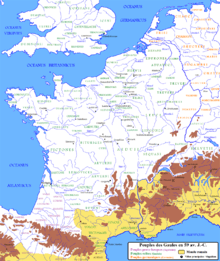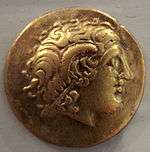Eburovices
The Eburovices, Aulerci Eburovices or Eburovici (Gaulish: "those who vanquish by the yew")[1][2] were a Gallic tribe, a branch of the Aulerci. They are mentioned by Julius Caesar (B. G. iii. 17) with the Lexovii. Pliny (H.N. xv. 18) speaks of the Aulerci, qui cognominantur Eburovices, et qui Cenomani. Ptolemy (ii. 8) makes the Αὐλέρκοι Ἐβουραϊκοί extend from the Ligeris (modern Loire) to the Sequana (modern Seine), which is not true. Their chief place was Mediolanum Aulercorum (modern Évreux, in Normandy). Their limits correspond to those of the later diocese of Évreux, and they are north of the Carnutes.

Name
They are mentioned as Aulerci Eburovices by Caesar (mid-1st c. BC),[3] as Aulerci qui cognominantur Eburovices by Pliny (1st c. AD),[4] and as Au̓lírkioioi̔ E̓bourouikoì (Αὐλίρκιοιοἱ Ἐβουρουικοὶ) by Ptolemy (2nd c. AD).[5][6]
The name Eburovices stems from Gaulish eburos ('yew') attached to the suffix -uices ('combatants, victors'), ultimately from Proto-Celtic *eburos ('yew'; compare with Old Irish ibar 'yew', or Middle Welsh efwr 'cow parsnip, hog-weed').[7][8] It means 'those who vanquish by the yew', in reference to the wood used to make bows or lances.[2]
The city of Évreux, attested as civitas Ebroicorum around 400 CE (Ebroicas in 511, Ebroas ca. 1034), is named after the tribe.[1][2]
Religion
In a sanctuary at Le Vieil-Évreux was found a votive altar with a dedication to a deus Gisacos.[9]
[A]ug(usto) deo Gisaco/ [Ta]uricius Agri/[co]la de suo po/suit
— Le Vieil-Évreux inscription.[9]
References
- Nègre 1990, p. 154.
- Delamarre 2003, p. 159.
- Caesar. Commentarii de Bello Gallico, 3:17
- Pliny. Naturalis Historia, 4:107
- Ptolemy. Geōgraphikḕ Hyphḗgēsis, 2:8:9
- Falileyev 2010, p. entry xxx.
- Delamarre 2003, pp. 159, 318.
- Matasović 2009, p. 112.
- Lajoye 2013, p. 45.
Bibliography
- Delamarre, Xavier (2003). Dictionnaire de la langue gauloise: Une approche linguistique du vieux-celtique continental (in French). Errance. ISBN 9782877723695.CS1 maint: ref=harv (link)
- Falileyev, Alexander (2010). Dictionary of Continental Celtic Place-names: A Celtic Companion to the Barrington Atlas of the Greek and Roman World. CMCS. ISBN 978-0955718236.
- Lajoye, Patrice (2013). "L'épigraphie religieuse mentionnant des théonymes ou des épithètes indigènes en Lyonnaise seconde.: Un état des lieux". In Hofeneder, Andreas; de Bernardo Stempel, Patrizia (eds.). Théonymie celtique, cultes, interpretatio = Keltische Theonymie, Kulte, Interpretatio (1 ed.). Austrian Academy of Sciences Press. pp. 45–50. ISBN 978-3-7001-7369-4. JSTOR j.ctv8mdn28.6.
- Matasović, Ranko (2009). Etymological Dictionary of Proto-Celtic. Brill. ISBN 9789004173361.CS1 maint: ref=harv (link)
- Nègre, Ernest (1990). Toponymie générale de la France (in French). Librairie Droz. ISBN 978-2-600-02883-7.CS1 maint: ref=harv (link)
![]()
